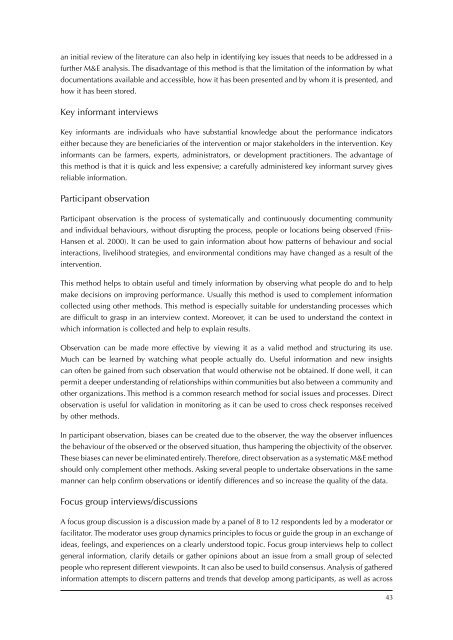A guide for practitioners
A guide for practitioners
A guide for practitioners
You also want an ePaper? Increase the reach of your titles
YUMPU automatically turns print PDFs into web optimized ePapers that Google loves.
an initial review of the literature can also help in identifying key issues that needs to be addressed in afurther M&E analysis. The disadvantage of this method is that the limitation of the in<strong>for</strong>mation by whatdocumentations available and accessible, how it has been presented and by whom it is presented, andhow it has been stored.Key in<strong>for</strong>mant interviewsKey in<strong>for</strong>mants are individuals who have substantial knowledge about the per<strong>for</strong>mance indicatorseither because they are beneficiaries of the intervention or major stakeholders in the intervention. Keyin<strong>for</strong>mants can be farmers, experts, administrators, or development <strong>practitioners</strong>. The advantage ofthis method is that it is quick and less expensive; a carefully administered key in<strong>for</strong>mant survey givesreliable in<strong>for</strong>mation.Participant observationParticipant observation is the process of systematically and continuously documenting communityand individual behaviours, without disrupting the process, people or locations being observed (Friis-Hansen et al. 2000). It can be used to gain in<strong>for</strong>mation about how patterns of behaviour and socialinteractions, livelihood strategies, and environmental conditions may have changed as a result of theintervention.This method helps to obtain useful and timely in<strong>for</strong>mation by observing what people do and to helpmake decisions on improving per<strong>for</strong>mance. Usually this method is used to complement in<strong>for</strong>mationcollected using other methods. This method is especially suitable <strong>for</strong> understanding processes whichare difficult to grasp in an interview context. Moreover, it can be used to understand the context inwhich in<strong>for</strong>mation is collected and help to explain results.Observation can be made more effective by viewing it as a valid method and structuring its use.Much can be learned by watching what people actually do. Useful in<strong>for</strong>mation and new insightscan often be gained from such observation that would otherwise not be obtained. If done well, it canpermit a deeper understanding of relationships within communities but also between a community andother organizations. This method is a common research method <strong>for</strong> social issues and processes. Directobservation is useful <strong>for</strong> validation in monitoring as it can be used to cross check responses receivedby other methods.In participant observation, biases can be created due to the observer, the way the observer influencesthe behaviour of the observed or the observed situation, thus hampering the objectivity of the observer.These biases can never be eliminated entirely. There<strong>for</strong>e, direct observation as a systematic M&E methodshould only complement other methods. Asking several people to undertake observations in the samemanner can help confirm observations or identify differences and so increase the quality of the data.Focus group interviews/discussionsA focus group discussion is a discussion made by a panel of 8 to 12 respondents led by a moderator orfacilitator. The moderator uses group dynamics principles to focus or <strong>guide</strong> the group in an exchange ofideas, feelings, and experiences on a clearly understood topic. Focus group interviews help to collectgeneral in<strong>for</strong>mation, clarify details or gather opinions about an issue from a small group of selectedpeople who represent different viewpoints. It can also be used to build consensus. Analysis of gatheredin<strong>for</strong>mation attempts to discern patterns and trends that develop among participants, as well as across43

















